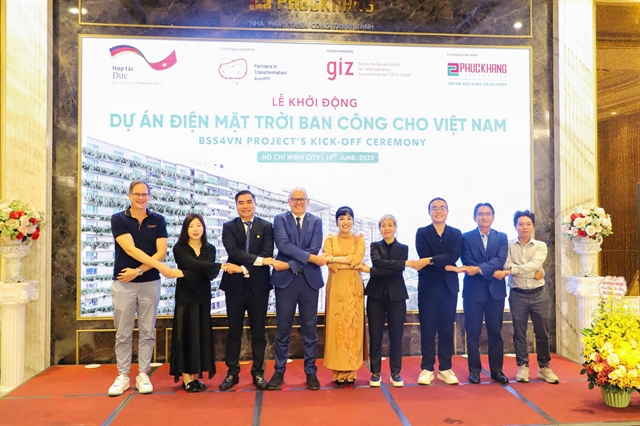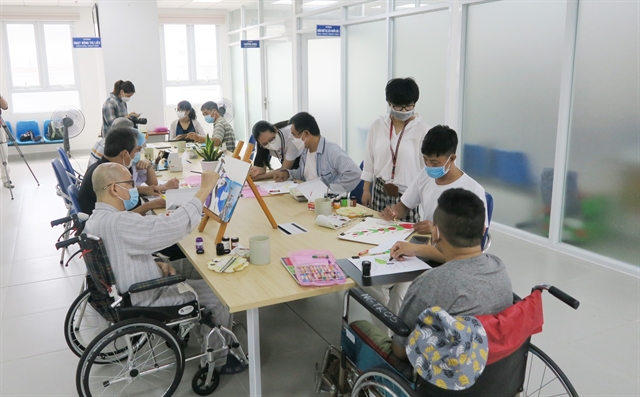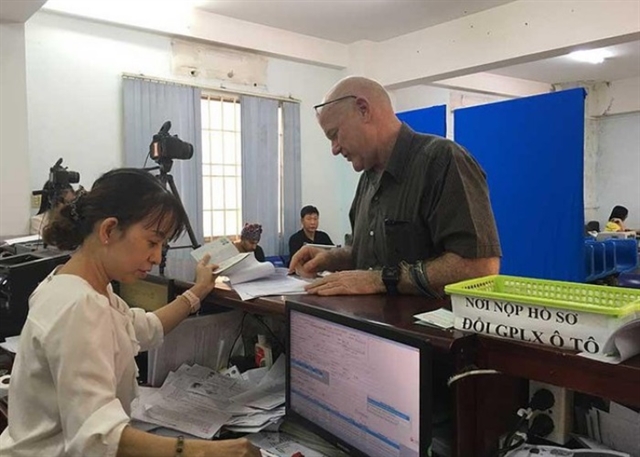 Society
Society

 |
| The painting class at the An Bình Hospital’s Rehabilitation Ward. — VNA/VNS Photo Đinh Hằng |
HCM CITY — Every Friday morning, Hồ Đắc Thắng asked his son to take him to the Rehabilitation Ward at the An Bình Hospital to participate in a painting class.
Since his first drawing class, Thắng has not missed a day.
Thắng, 59, from Thủ Đức City in HCM City, has always enjoyed drawing but didn't always have the opportunity.
A busy work life meant Thắng's passion for drawing was almost extinguished.
However, when he heard about a free drawing class for stroke rehabilitation patients, even though the class was far away from his home, Thắng was determined to participate.
"I am very happy being here because I met many people in the same situation as me. I learn how to hold a brush and mix colours. My childhood passion rose, my spirit was more relaxed and my fingers seemed to be more flexible," said Thắng.
Phạm Xuân Sang, 39, from District 8, is another class member.
Although he was a bit shy at first because he didn't think he could draw very well, all inhibitions were lost after two lessons.
Whenever he finishes a painting, he asks his wife to take a picture and post it online to show off to friends and relatives.
More importantly, his spirit improves immensely.
"Initially, I was very bored and sad when I had a stroke. Many nights I cried silently and was unable to sleep. I am more optimistic when I come here to see many people in the same situation as me, talk with them, paint, and colour. I tell myself to try to integrate into life," said Sang.
The painting class is organised by the Rehabilitation Ward of the An Bình Hospital in District 5, HCM City.
Lê Khánh Điền, head of the ward, said that he received a scholarship to study in Australia in 2012, majoring in rehabilitation.
Returning to Việt Nam in 2013, he proposed to organise rehabilitation activities for patients more systematically, including opening a communication painting class.
With the consent of the hospital's leaders, Điền asked student volunteers from the HCM City University of Architecture and the HCM City University of Fine Arts to guide the patients.
He suggested benefactors buy tables, chairs, tools, drawing papers, brushes, and paint colours for the class.
Since 2013, the communication painting class has attracted many patients.
Each session has about 20 participants, some of whom have attended the class for six to seven years. Others have recovered but still occasionally visit the class.
Thanks to the class, many patients have discovered their hidden potential and have produced beautiful drawings.
An Binh Hospital even once held an exhibition of paintings by members of the communication painting class.
They hope that next year they will be able to hold a similar painting exhibition on a larger scale.
Mental support
Patients often have hemiplegia, speech disorders, and swallowing dysfunction after a stroke, according to Điền.
Patients need time to rehabilitate to return to daily activities.
Communication painting is important in stimulating brain development and helping patients recover better.
The painting class helps to relieve their minds and helps their limbs to be more flexible.
"Psychological and mental comfort is one of the important factors for patients to recover. When patients communicate with each other, they will have confidence and motivation to overcome the immediate difficulties," said Điền.
Many patients who joined the drawing class recovered faster than others.
Some patients, after a stroke, fall into depression. They have no motivation to recover, have difficulty speaking, and have weak limbs.
After the drawing class, many became more lively and alert.
Nguyễn Thanh Tuấn, 46 and living in District 8, suffered a stroke more than one year ago. Since then, he has been taciturn.
However, when he learned about the drawing class, he became cheerful and optimistic and worked hard to return to recover.
As a result, his limb movements grew more flexible, and other movements gradually recovered.
Now he can ride his electric bike to the hospital by himself.
"Knowing that my health had improved, my company began looking at me returning to work. Next year, I will go back to work," said Tuấn.
Hồ Hải Trường Giang, director of the An Bình Hospital, said that, on average, the hospital's Rehabilitation Ward receives about 200 patients per day for examination and physical therapy.
To meet the patients' demands, the ward has equipped many modern machines for practising physical therapy and restoring motor function.
Speech therapy activities also help restore the patients' speaking and swallowing functions.
The ward is implementing therapeutic activities to improve the skills of holding, changing clothes and bathing to help patients gradually control their daily activities.
Based on the success of the communication painting class, the An Bình Hospital will open more classes, such as music therapy, chess, video games and calligraphy, for patients after dementia treatment, strokes, and brain damage. — VNS









